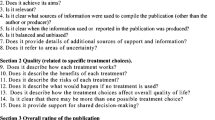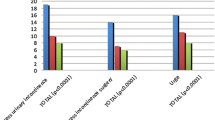Abstract
Introduction
In July 2011, the US Food and Drug Administration (FDA) issued a safety communication regarding serious complications associated with surgical mesh for pelvic organ prolapse, prompting increased media and public attention. This study sought to analyze internet search activity and news article volume after this FDA warning and to evaluate the quality of websites providing patient-centered information.
Methods
Google Trends™ was utilized to evaluate search engine trends for the term “pelvic organ prolapse” and associated terms between 1 January 2004 and 31 December 2014. Google News™ was utilized to quantify the number of news articles annually under the term “pelvic organ prolapse.” The search results for the term “pelvic organ prolapse” were assessed for quality using the Health On the Net Foundation (HON) certification.
Results
There was a significant increase in search activity from 37.42 in 2010 to 57.75 in 2011, at the time of the FDA communication (p = 0.021). No other annual interval had a statistically significant increase in search activity. The single highest monthly search activity, given the value of 100, was August 2011, immediately following the July 2011 notification, with the next highest value being 98 in July 2011. Linear regression analysis of news articles per year since the FDA communication revealed r2 = 0.88, with a coefficient of 186. Quality assessment demonstrated that 42 % of websites were HON-certified, with .gov sites providing the highest quality information.
Conclusions
Although the 2011 FDA safety communication on surgical mesh was associated with increased public and media attention, the quality of relevant health information on the internet remains of poor quality. Future quality assurance measures may be critical in enabling patients to play active roles in their own healthcare.

Similar content being viewed by others
References
Machin SE, Mukhopadhyay S (2011) Pelvic organ prolapse: review of the aetiology, presentation, diagnosis and management. Menopause Int 17(4):132–136
Wang LC, Awamlh BA, Hu JC, Laudano MA, Davison WL, Schulster ML et al (2015) Trends in mesh use for pelvic organ prolapse repair from the Medicare database. Urology 86(5):885–891
Mistrangelo E, Mancuso S, Nadalini C, Lijoi D, Costantini S (2007) Rising use of synthetic mesh in transvaginal pelvic reconstructive surgery: a review of the risk of vaginal erosion. J Minim Invasive Gynecol 14(5):564–569
Chughtai B, Mao J, Buck J, Kaplan S, Sedrakyan A (2015) Use and risks of surgical mesh for pelvic organ prolapse surgery in women in New York state: population based cohort study. BMJ 350:h2685
US Food and Drug Administration (2008) FDA Public Health Notification: serious complications associated with transvaginal placement of surgical mesh in repair of pelvic organ prolapse and stress urinary incontinence. Available from: http://www.fda.gov/MedicalDevices/Safety/AlertsandNotices/PublicHealthNotifications/ucm061976.htm
US Food and Drug Administration (2011) UPDATE on serious complications associated with the transvaginal placement of surgical mesh for pelvic organ prolapse: FDA safety communication. Available from: http://www.fda.gov/MedicalDevices/Safety/AlertsandNotices/ucm262435.htm
Glynn RW, Kelly JC, Coffey N, Sweeney KJ, Kerin MJ (2011) The effect of breast cancer awareness month on internet search activity—a comparison with awareness campaigns for lung and prostate cancer. BMC Cancer 11:442
Davis NF, Smyth LG, Flood HD (2012) Detecting internet activity for erectile dysfunction using search engine query data in the Republic of Ireland. BJU Int 110(11 Pt C):E939–E942
Pelat C, Turbelin C, Bar-Hen A, Flahault A, Valleron A (2009) More diseases tracked by using Google Trends. Emerg Infect Dis 15(8):1327–1328
Althouse BM, Ng YY, Cummings DA (2011) Prediction of dengue incidence using search query surveillance. PLoS Negl Trop Dis 5(8):e1258
Ginsberg J, Mohebbi MH, Patel RS, Brammer L, Smolinski MS, Brilliant L (2009) Detecting influenza epidemics using search engine query data. Nature 457(7232):1012–1014
Eysenbach G, Kohler C (2002) How do consumers search for and appraise health information on the world wide web? Qualitative study using focus groups, usability tests, and in-depth interviews. BMJ 324(7337):573–577
Chitika (2013) The value of Google result positioning. Available from: http://chitika.com/google-positioning-value. Accessed 17 September 2015
van Deursen AJAM, van Dijk JAGM (2009) Using the internet: skill related problems in users’ online behavior. Interact Comput 21(5–6):393–402
Boyer C, Selby M, Scherrer JR, Appel RD (1998) The health on the net code of conduct for medical and health websites. Comput Biol Med 28(5):603–610
Starman JS, Gettys FK, Capo JA, Fleischli JE, Norton HJ, Karunakar MA (2010) Quality and content of internet-based information for ten common orthopaedic sports medicine diagnoses. J Bone Joint Surg 92(7):1612–1618
Lopez-Jornet P, Camacho-Alonso F (2009) The quality of internet sites providing information relating to oral cancer. Oral Oncol 45(9):e95–e98
Zermatten A, Khazaal Y, Coquard O, Chatton A, Bondolfi G (2010) Quality of web-based information on depression. Depress Anxiety 27(9):852–858
Rice NT, Hu Y, Slaughter JC, Ward RM (2013) Pelvic mesh complications in women before and after the 2011 FDA public health notification. Female Pelvic Med Reconstr Surg 19(6):333–338
Lawrentschuk N, Abouassaly R, Hackett N, Groll R, Fleshner NE (2009) Health information quality on the internet in urological oncology: a multilingual longitudinal evaluation. Urology 74(5):1058–1063
Alkhateeb S, Lawrentschuk N (2011) Consumerism and its impact on robotic-assisted radical prostatectomy. BJU Int 108(11):1874–1878. doi:10.1111/j.464-410X.2011.10117.x
Mulhall JP, Rojaz-Cruz C, Muller A (2010) An analysis of sexual health information on radical prostatectomy websites. BJU Int 105(1):68–72
Mirkin JN, Lowrance WT, Feifer AH, Mulhall JP, Eastham JE, Elkin EB (2012) Direct-to-consumer Internet promotion of robotic prostatectomy exhibits varying quality of information. Health Aff (Millwood). 31(4):760–769
Solomon ER, Janssen K, Krajewski CM, Barber MD (2015) The quality of health information available on the internet for patients with pelvic organ prolapse. Female Pelvic Med Reconstr Surg 21(4):225–230
Sajadi KP, Goldman HB, Firoozi F (2011) Assessing internet health information on female pelvic floor disorders. J Urol 186(2):594–596
Kakos A, Lovejoy D, Whiteside J (2015) Quality of information on pelvic organ prolapse on the Internet. Int Urogynecol J 26(4):551–555
Minaglia S, Kaneshiro B, Soules K, Harvey S, Grzankowski K, Millet L et al (2012) Assessment of internet-based information regarding pelvic organ prolapse and urinary incontinence. Female Pelvic Med Reconstr Surg 18(1):50–54
Lella A. comScore Releases April 2014 U.S. Search Engine Rankings. Available from: http://www.comscore.com/Insights/Market-Rankings/comScore-Releases-April-2014-US-Search-Engine-Rankings. Accessed 17 September 2015
Author information
Authors and Affiliations
Corresponding author
Ethics declarations
Institutional review board approval
This study was exempt from institutional review board approval for the following reason: research involving the collection or study of existing data, documents, records, pathological specimens, or diagnostic specimens, if these sources are publicly available or if the information is recorded by the investigator in such a manner that subjects cannot be identified, directly or through identifiers linked to the subjects.
Financial disclaimer
None.
Conflicts of interest
None.
Rights and permissions
About this article
Cite this article
Stone, B.V., Forde, J.C., Levit, V.B. et al. Trends in internet search activity, media coverage, and patient-centered health information after the FDA safety communications on surgical mesh for pelvic organ prolapse. Int Urogynecol J 27, 1761–1766 (2016). https://doi.org/10.1007/s00192-016-3040-6
Received:
Accepted:
Published:
Issue Date:
DOI: https://doi.org/10.1007/s00192-016-3040-6




